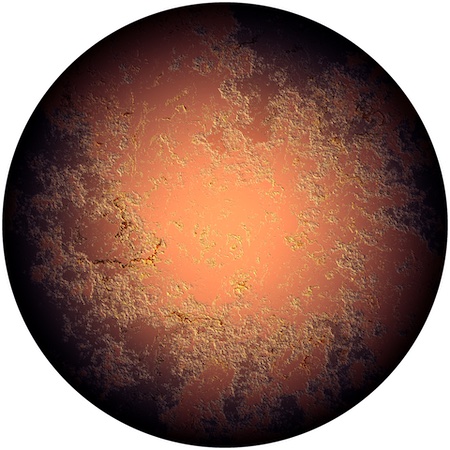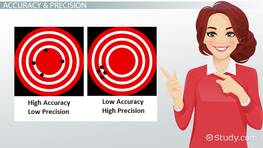Particle | Definition, Properties & Examples
What are examples of particles?
Particles can be large, small, microscopic, or subatomic. Some examples may be a grain of sand, an oxygen atom, or an electron.
What exactly is a particle?
A particle is a small, discrete point-like piece of matter or energy. This could be an atom or electron in particle physics, or a car or a shopping cart in an engineering study.
Recommended lessons and courses for you
A particle is a small discrete portion of something; this could be large or small, or even microscopic. Depending on what the scientist or engineer is studying, the definition of the particle may change. A particle physicist will consider a neutron, proton, or electron as particles or, if they go even smaller, they can look at quarks or leptons. An engineer studying traffic patterns may consider cars to be the particles they need to focus on in order to get a better picture of how to solve the problem.
Particles are referred to as point-like objects. In the engineering example, the cars can be seen as a dot on a map to represent the cars and their motion. And for science, all atomic particles are usually visualized as a point or sphere when drawn or depicted in models. In ancient times, particles were thought to be the smallest portion of what was being studied. Ancient Greeks described particles as small, hard spheres that were indivisible and when Ernest Rutherford introduced the idea of an atom, he built from this idea. Later, as our technology got better, scientists were able to see even smaller parts within the atoms. However, the definition of a particle as a point-like object that is the smallest understandable portion of what is being studied has remained the same. In the end, the scientists or the engineers simply state what they are using as their particles. Some may be quarks and leptons as mentioned above, or it may be molecules of an element, or something representative of what the smallest unit being studied is like a car on the roadway or shopping carts in a mall.
Some particles may be stationary and others may be in motion. In the shopping cart example, the carts will be in motion around the store or mall, and studying how they move will help to design more efficient traffic patterns. In studying an element in its molecular form, the molecules may be generally stationary if the element is in a solid state.
In science, a particle is defined as any basic unit of matter and energy. A particle refers to a quantity of matter that is used by scientists or engineers to construct theories about their field of study. There is no particular size restriction on defining a particle. As mentioned above the actual choice of what a particle is, is up to the scientist. Some particle physicists will only look at quarks, others leptons, and still others atoms. In chemistry, the scientist may look at a particle as a molecule of a compound or individual atoms. In engineering, the particles may be representative of a whole unit of something, but it will also be the smallest point-like instance, like a car in traffic or people in a store.
The main property of a particle is that it is discreet and individual and, therefore, can be counted. In order to count them, the particles also need to be identical to each other. In the case of microscopic and subatomic particles, it is easy to understand that a proton in one atom is identical to a proton elsewhere. In the engineering car example, it might be a bit harder to understand. But in this example, the definition of a car is that it has a motor and wheels, so trucks, cars, motorcycles, or any other vehicle that matches that description are counted in order to study the flow of traffic.
Particles can be stationary or in motion. A stationary particle does not move, but particles in motion have to move through particle transport. Particle transport is when the point-like matter moves through a fluid (remember air is actually considered a fluid in science). Fluid transport allows for the diffusion of particles and if the fluid is removed it can allow for the concentration of particles. For example, if particles of salt are put in a beaker of water, the particles will spread out throughout the fluid, but as the water evaporates the salt particles will move back together and concentrate into a crystal form.
Particles can also behave like a wave. This is called wave-particle duality. In quantum field theory, it is explained that fundamental particles each have their own field and these fields are what the particle can move around in a wave fashion. So a fundamental particle like a photon can behave as both a point-like particle and a wave over the field.
There are three ways to classify particles, by their size, composition, and/or their stability. Each will be explained below.
Based on Size
So far, a variety of particles have been discussed. All of them can be sorted by their size. There are macroscopic, microscopic, and subatomic particles. In order to understand these, there is a need to define what an atom is. An atom is a single, indivisible particle of a specific element from the periodic table. There are 118 elements, but there are a few that are theoretically predicted but have not been observed. Ninety-one of them have been observed in nature, and several of the remaining ones have been formed in a laboratory setting. When several atoms of two or more elements are bound together, they form a molecule. For example, an atom of sodium and an atom of chloride will bond together to make a molecule of salt. When there is a large collection of many atoms of an element, they can form together to make a macroscopic clump of the element that can be observed, such as a solid gold ring or nugget.
 |
- Macroscopic particles- these are the largest of particles that can be seen by the naked eye. Examples of these would be the cars and shopping carts as mentioned earlier, but could also be rocks or crystals that are formed from compounds or elements.
- Microscopic particles- these particles are small enough to require at least a microscope to see them. Examples of these are individual atoms and single molecules of a compound.
 |
- Subatomic particles- these are particles that are below (sub) the level of an atom. These are the elementary particles of electrons, neutrons, and protons as well as the fundamental particles of quarks and leptons.
Based on Composition
Quarks and protons are fundamental particles, meaning that they cannot be broken down any further. There can be different types of quarks and leptons, such as up quarks or down quarks, but they are the smallest component of matter. There are also elementary particles which are neutrons, electrons, and protons. These make up larger particles that are called composite particles, which are things like atoms, compounds, and larger particles like what engineers would use. All particles can be defined by either their size, composition, and/or their stability.
Based on Stability
Elementary and composite particles can be classified by their stability or their ability to remain intact without decaying into smaller and less massive particles. Fundamental particles are already the smallest, least massive particles and are considered fully stable. When a macroscopic particle is unstable, it may break into pieces, like a rock becoming pebbles. For macroscopic particles, the stability is based on if they are the smallest, least massive piece of matter that is not releasing any electrically charged particles like electrons or protons. This means a stable atom will not decay into a less massive atom easily. On the periodic table, the noble gases on the last column on the right are the most stable atoms that are known. When atoms decay, they will always be less massive than their original state.
 |
 |
Some examples of particles are planets, a carbon atom, and an electron. Planets are macroscopic particles that can easily be seen in the night sky or with the help of a telescope. The study of planets in Astronomy uses planets as countable particles that allow scientists to make predictions and conclusions about our universe. A carbon atom is a microscopic particle. One alone cannot be seen by the naked eye, but many of them can result in a mark on a paper from a carbon-leaded pencil. When chemists study the structure and behavior of compounds and groups of atoms, they can hypothesize and draw conclusions on how different elements will react to each other or decay. An electron is the negatively charged subatomic particle that circles the nucleus (made of protons and neutrons) of an individual atom. Particle physicists study the addition and removal of electrons from and to atoms to study how the elements decay and some even study how the electron, protons, and neutrons break into quarks and leptons.
A particle is a small discrete portion of something, this could be large or small, or even microscopic. Some particles may be stationary and others may be in motion. There are three ways to classify particles including by their size, composition, and their stability. Some examples of particles are planets, a carbon atom, and an electron. Quarks and protons are fundamental particles. Fundamental particles are already the smallest, least massive particles and are considered fully stable.Elementary and composite particles can be classified by their stability or their ability to remain intact without decaying into smaller and less massive particles.
Particles are very important in science and engineering. The study of them allows us to understand the world around us from the very, very small to the big overall flow of matter through the universe. Particle physics explains the world of atoms, quarks, and leptons. Engineering studies particles to help traffic to flow better, to understand how the infrastructure of cities and towns around the world works and can be improved. Particles make up everything in and around us so studying and understanding their details allows for a better life for all.
Video Transcript
Definition of a Particle
Imagine picking up a rock and smashing it with a hammer so that it breaks up into smaller fragments. Then, successively break each of the fragments into even smaller fragments, until the resulting pieces are so small that they cannot be further broken down. These non-breakable fragments are one example of particles.
A particle refers to a quantity of matter that is used by scientists to construct theories about their field of study. There is no particular size restriction on defining a particle. Astronomers can define particles to be stars in the night sky, while physicists can define particles to be electrons. It mostly depends on the scientific field and theory under development.
Particles Properties and Classification
You may ask, 'If there is such a large variety of objects that can be thought of as particles, is there a common theme among all of them?' Well, there is, and we will now discuss it.
Scientists often think of particles as point-like objects, meaning that they are considered shapeless for the purposes of the theory. For example, when a chemist is studying the properties of gas particles in a container, he or she would think of them as little shapeless objects that bounce against the walls of their container. If an engineer is studying traffic flow on a busy street, he or she would consider all the vehicles to be particles, disregarding whether a particular vehicle is a bus, car, or motorcycle.
Although all of the previous examples described particles in motion, it is important to note that particles can be permanently stationary objects, at least for the purposes of the theory. For example, the carbon atoms that make up graphite, a primary constituent of pencil lead, can be thought of as particles. Let's briefly discuss atomic and subatomic particles, which are very important in many scientific fields.
Atomic Particles
Democritus, an ancient Greek philosopher, had a thought experiment similar to the example with the rock fragments. If you take any piece of matter and keep dividing it in half, you will eventually reach a point where it could no longer be divided. He called these indivisible particles atoms.
It's important to note that the scientific definition of an atom is quite different from that of Democritus. As defined in the Encyclopedia Britannica, an atom is the smallest unit into which matter can be divided without the release of electrically charged particles. Although atoms, as we think of them in modern times, have an internal structure, they are often treated as particles that are the building blocks of all matter and chemical reactions. As of today, scientists discovered 118 types of atoms, as can be seen in the periodic table. These atoms can bond together to form molecules, which are structures that contain two or more atoms held together. Subsequently, molecules form more complex structures that ultimately make up all the things that we see around us.
Subatomic Particles
In some cases, atomic particles are insufficient to describe physical phenomena. In these instances, scientists classify smaller-than-atom objects as particles, also known as subatomic particles. Let's look at a few examples.
Electrons are subatomic particles that are often used by electrical engineers to explain, at the most basic level, how digital devices, such as complex as computer chips, function. Protons and neutrons are subatomic particles that are used in many scientific theories. They also constitute the nuclei of atoms. There are many other types of subatomic particles, some of which have been discovered not too long ago. Who knows, maybe you will discover another one.
Lesson Summary
As we have seen today, particles can be thought of as point-like objects that describe the phenomenon under study. They can be very large, such as celestial bodies, or very small, such as electrons. They can even be objects we observe in the real world, like cars moving down a highway. As long as it describes the movement of units, a particle can really be anything. Despite all this, though, particles themselves can be thought of as being shapeless. However, particles can be stationary, such as atoms (as defined by Greek philosopher Democritus, a piece of matter that can no longer be divided) in a crystal, or in constant motion, such as grains of sand in the wind. We have also discussed atomic (like the single units of the elements on the periodic table) and subatomic particles (like protons and neutrons, which make up the nuclei of atoms and electrons, which orbit the nuclei), which are the constituents of all matter. Can you think of some other examples of particles?
Register to view this lesson
Unlock your education
Become a Study.com member and start learning now.
Become a memberAlready a member? Log in
Go backResources created by teachers for teachers
I would definitely recommend Study.com to my colleagues. It’s like a teacher waved a magic wand and did the work for me. I feel like it’s a lifeline.















